

SCAMP SAILBOAT & The Red Lantern Fleet
© 2024 Scamp Sailboat / Jib & Jigger Incorporated
YOUR OWN SCAMP
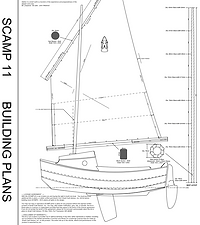
Build from Plans
Ready to build your own? You can order your own set of printed plans or a PDF download right here at this site. Welcome aboard!

Build from a Kit
The famously detailed CNC-cut SCAMP kits are available all over the world. See links below to find an authorized kit reseller or buy here and get started the easy way.

Buy a Fiberglass Model
Why build a SCAMP when you can start sailing and exploring now? The renowned fiberglass SCAMP from Gig Harbor Boat Works can be customized to your tastes as well. Click here to visit their site.
Dave Lucas, FL
It was blowing a solid 12 to 15 with higher gusts and us hot-rodders were having a ball showing off and speeding around the slower boats when what do I see ahead of me but a Scamp. ... only a hundred yards or so so we figured to catch him in about two minutes; it didn’t work out that way. It took us about two miles to finally get to him ...These guys were just sitting drinking beer and hauling ass easy as you please. They could tack and jibe and mess around like it was dead calm, where we were having to be really careful. That’s impossible—this kind of performance cannot come from a clunky little 12-foot boat. This thing somehow ignored everything I thought I know about hull speed. I strongly recommend this boat to anyone who wants a simple, lightweight, safe, dry, fast boat.”
Our own youthful dreams often featured small boats in starring roles. Aboard these simple, stalwart little vessels we'd venture across nebulous bodies of water in search of distant wild shorelines or uncharted islands. We'd land, hike into the interior, and make camp. But always our boats offered refuge from any threat, including summer storms, which we'd wait out beneath our boom tents. At night we'd read sea stories by oil lantern and sleep under a blanket of stars.
Curiously, never once did these visions include negative images of wrestling with a heavy mast and complex rigging, fussing with a smelly, recalcitrant outboard, or being held off shore by our boat's draft. And even when we pictured the afternoon breeze kicking up whitecaps, never once did the vision include a chilly capsize.
It was the dream of returning to those simple pleasures that inspired thoughts of S.C.A.M.P. (Small Craft Advisor Magazine Project). That and a persistent desire to go over "there"—that place we often see but are unable to reach. It seems to happen on every cruise. Never mind that we're usually sailing the smallest boat around for miles, we always come upon some ultra-shallow lagoon or serpentine tidal stream that disappears into the reeds, trees and rushes. To get in there—to really commune with nature—a boat needs to be light, shallow and easily propelled—and preferably flat-bottomed in case we decide to stay right though the ebb. —Josh Colvin
Features : Water Ballast Tank • Offset centerboard • Massive Flotation Stowage Cabin • "Veranda" Overhanging Cabintop • Kickup Rudder Flat Bottom and Skegs for Beaching • Voluminous Stowage Lockers 8' 3" Cockpit Sole Single Berth • Convert Cockpit Seats to Double Berth
Designer : John Welsford
Additional Development: Kees Prins, Brandon Davis, Howard Rice

First Launched
Sail Numbers
11'11"
Length Overall
Approximate
MANY WAYS TO SCAMP

SCAMP MERCH

SCAMP Building Kit + Foils

SCAMP Red Lantern Crew Neck Sweatshirt

SCAMP Red Lantern Shirt

SCAMP Building Plans PDF DOWNLOAD

SCAMP Building Plans

SCAMP Articles Package

SCAMP Brass Name Plate

Limited Edition SCAMP Poster

A Boat Called SCAMP

Official SCAMP Burgee
SCAMP LINKS
Ordering plans or kits.
United States
Small Craft Advisor
Duckworks Boat Builders Supply
Little Wooden Boat Company
Jordan Boats
Denmark/ E.U.
Boatkits.eu
Owner Gallery
Do you own a SCAMP? Make sure to send us a photo of your boat for our Gallery page above.
Talk to other fans and owners at our Group page above, or at a popular Facebook group.
Ordering fiberglass model.
Gig Harbor Boatworks
Rigging and Sails
Talk to other owners, builders and fans at the scamp message board here, our group page above, or at a popular facebook group., ordering kits.
FRANCE/ U.K./ E.U.
Newyd Marine
SCAMP Building Camps
The pocket yacht, small craft advisor magazine.
Do you own a SCAMP? Make sure to send us a photo of your boat for our Gallery page above. Send your photo with your name, boat name and sail number to: [email protected]
Talk to other owners, builders and fans at our SCAMP Message Board , or here at Group page above, or at a popular Facebook group.
International registry, popular scamp youtube videos of the boat in action. intentional capsize scamp agility scamping around gig harbor scamp scamp in everglades challenge scamp 3-day cruise scamp video tour.
For other questions contact: [email protected]
Copyright Jib & Jigger Incorporated DBA Small Craft Advisor
Campy's "WICKED BEAT"
All days should be like today!
Friday, February 1, 2019
Building scamp, an 11 foot long, wood sailboat..
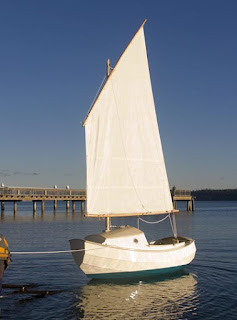
Keep us all up to date with picture's. Sounds like fun...
Post a Comment

Small Craft Advisor
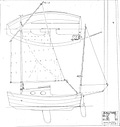
Boat Designs: Evaluating SCAMP’S Big Sister
(this new welsford cruiser checks a lot of boxes…).
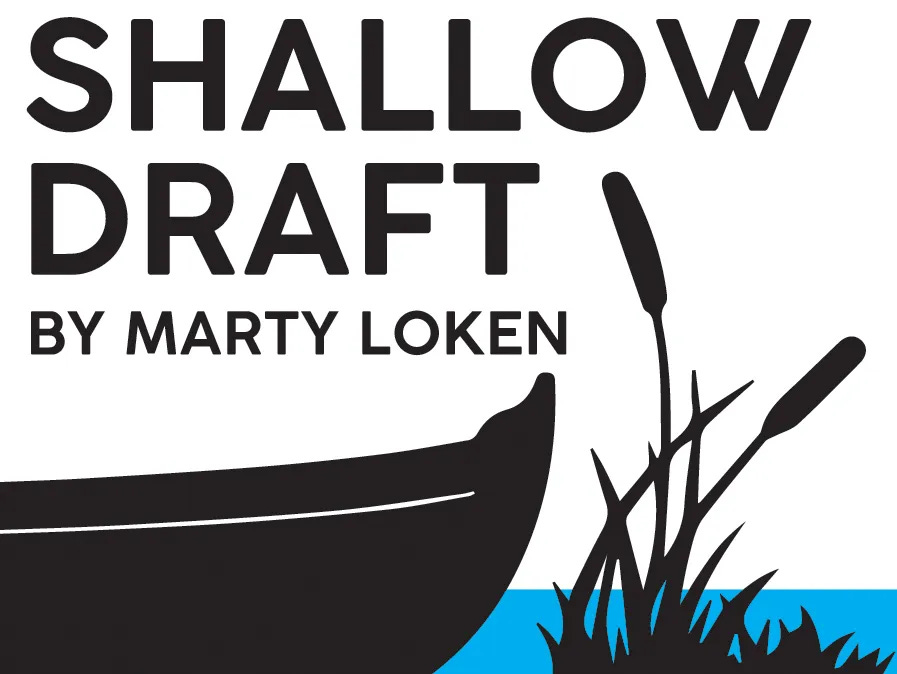
Over the past few days I’ve had email exchanges with John Welsford, New Zealand designer, regarding a brainstorm that’s been percolating in his clever, whimsical noggin: A bigger, more commodious takeoff on his wildly popular SCAMP design.
As most SCA readers know, the 11’ 11” SCAMP design was conceived 13 years ago when Josh Colvin, editor of this fine publication, asked Welsford to come up with a new kind of small cruising boat—one small enough to explore the most hard-to-penetrate backwaters, while being easy to rig, light enough to trailer with the smallest of tow vehicles, surprisingly great under sail, and comfy for overnight camp-cruising adventures. So, following some tweaks by designer and master boatbuilder Kees Prins, the resulting sailboat was dubbed SCAMP, for Small Craft Advisor Magazine Project.
SCAMP DRAWING…
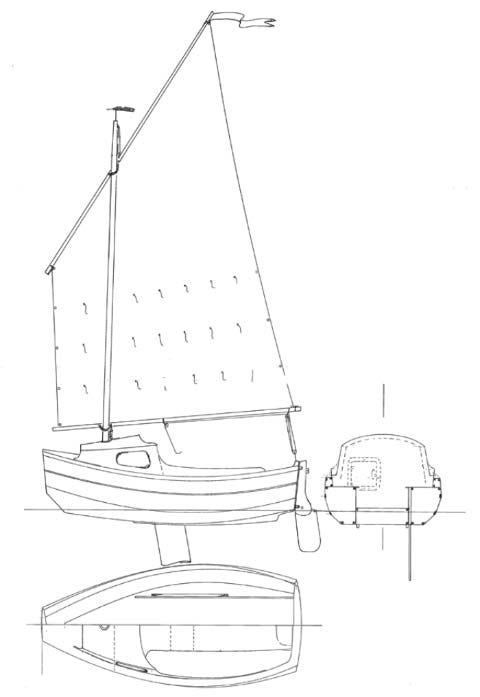
The rest is history: More building plans and kits for SCAMP have been sold over the years than any other small cruising boat we can think of. Besides the original wooden version, Gig Harbor Boat Works was licensed in 2013 to produce a fiberglass SCAMP, and the little giant killer—in wood and fiberglass—has since its debut been at the center of various small-boat rallies, workshops and sailing events.
While SCAMPs are still being built worldwide by enthusiasts, plan and kit sales have slowly been approaching what might be a kind of saturation point. It’s not that “everyone who wants a SCAMP has already built one,” but we get the feeling that it’s time for something new and different—like a SCAMP-inspired design that has the personality and quirky appeal of the original boat, but with more creature comforts (for an aging population of SCAMP lovers).
Meet SCALLYWAG, John Welsford’s big sister to SCAMP, a 15’ 4” x 7’ 3” wonder with a “real” cabin, tabernacle mast, mizzen sail, powerful main, water-ballast tanks, sitting headroom down below…and like SCAMP, faster than many onlookers might expect.
SCALLYWAG DRAWING…

This might turn out to be a timely, common-sense follow-up to the successful SCAMP design—so tempting that John Welsford is talking about building one for himself.
(As a footnote, we might add that in 2008, prior to the introduction of SCAMP in 2010, Welsford came up with another design that was similar to but somewhat larger than SCAMP—called TREAD LIGHTLY, which measured 13’ overall, with a beam of 5’ and addition of a mizzen. The series of similar hulls began with PEANUTS, an experimental build that never quite made the plans list. That design led to TENDER BEHIND, then SHERPA, then TREAD LIGHTLY, then SCAMP, then SCRAPS and now SCALLYWAG. Quite a series!)
TREAD LIGHTLY drawing…immediate predecessor to SCAMP)
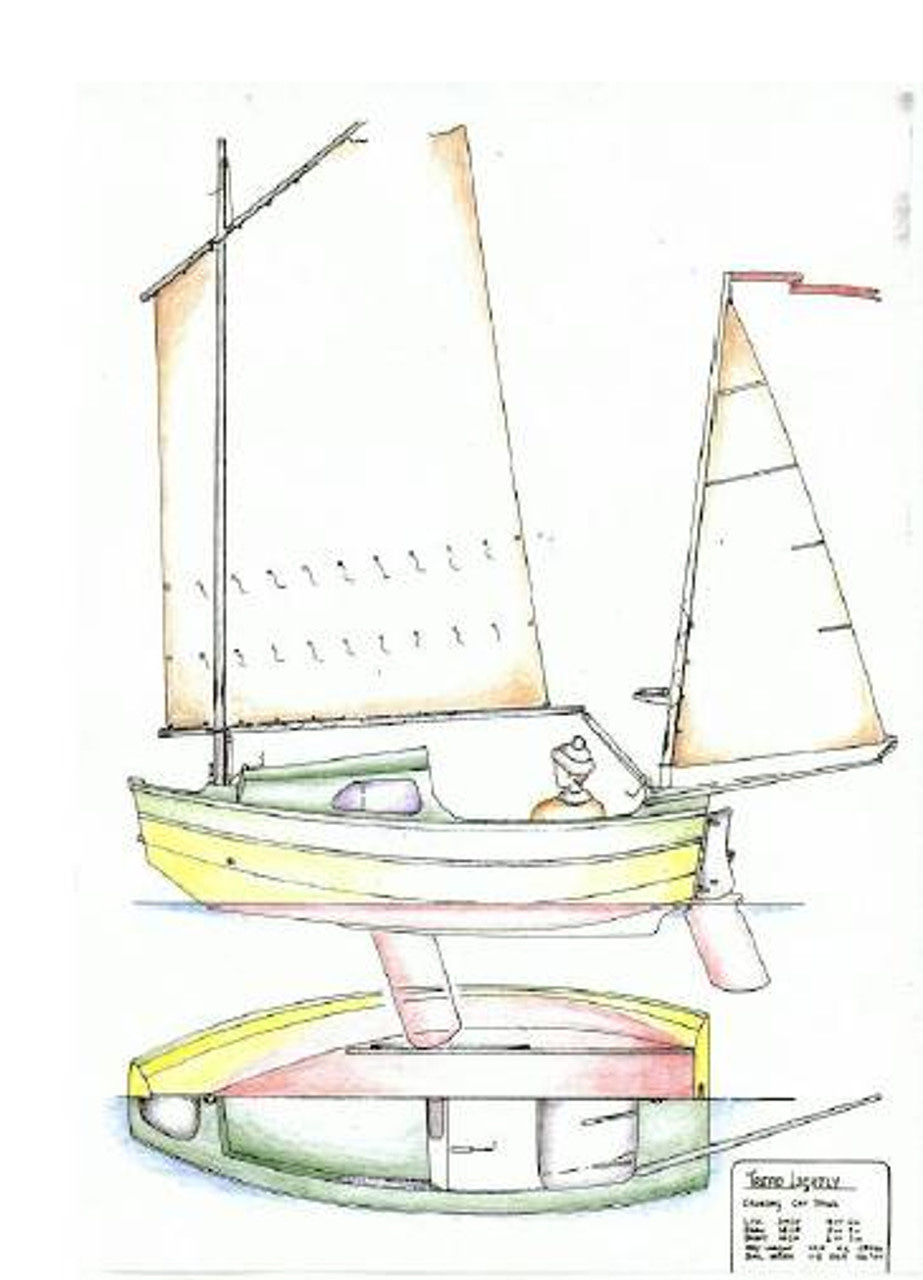
Here is John Welsford’s description of the SCALLYWAG design:
“I’ve had a number of people tell me they love SCAMP, but they’d like a ‘real’ cabin—something that would provide shelter for a couple of friends to overnight out of the rain; somewhere with space enough for four to sit and chat over coffee or rum on a cold evening; somewhere with a bench for a cooker, a table to eat the food off of, and lockers for all the essentials…and room for the skipper and first mate to stretch out and sleep in comfort.
“SCALLYWAG is not so big as to make launching and retrieving a chore; her mainmast is in a tabernacle, which makes standing it up easy-peasy for clients who don’t like the idea of lifting a mast that size vertically into place. Her mizzen is light enough to not be a worry, too, in that respect.
“The rig is a powerful one, but easy to access for reefing, and she will heave to under mizzen with the main let free so she sits mostly head-to-wind, dry and restful if a gust has to be waited out.
“I’ve added a pair of big water tanks for ballast, so with that and her beamy shape she’ll be very stable. Her cockpit self-drains, the motor is inside the tall transom for easy access, and while there’s room in the cockpit for four, she’ll be easy to single-hand and relaxing to sail.
“While the relationship between SCALLYWAG and SCAMP is obvious, it’s not just the styling. The backroom calculations in hydrodynamics suggest she’ll handle well, and be faster than many expect. With high stability and the ability to sit upright when aground, she’ll be able to transition from hiding in the mud or sand up a creek somewhere, to making a longer coastal passage without any fuss.
“Construction is simply plywood over ply bulkheads, with stringers to line everything up, and with considerable buoyancy just in case. The plans will have scale drawings of all major components, and we anticipate soon having printable full-sized templates for frames and other key items.”
As for specifications, beyond the overall length of 15’ 4” and beam of 7’ 3,” SCALLYWAG will have board-up draft of 10,” a board-down draft of 3’ 4,” a total sail area of 143 s.f. and a fully-rigged dry weight of 750 lbs. (Incidentally, the beam-to-length ratios of SCAMP and SCALLYWAG are almost identical.)
John Welsford says that plans for SCALLYWAG will be available on December 1, but he can take orders in the meantime. Price will be $245 U.S. funds for emailed, printable PDFs, and the plans can be ordered via John’s website: jwboatdesigns.co.nz (Joel Bergen, well-known for the Welsford Navigator he built and sails in many Northwest small-boat events, will be developing a set of SCALLYWAG patterns in the not-distant future, according to Welsford. Editor’s note: We heard from Joel yesterday; he’s hoping to develop CAD-produced patterns “in a few weeks,” now that he’s received initial SCALLYWAG drawings. Stay tuned; we’ll provide updates on plans and patterns in this space.)
FIRST IMPRESSIONS OF THE SCALLYWAG DESIGN:
Eager to hear what SCAMP-savvy friends might have to say about the SCALLYWAG specs and just-released drawing, we sought initial reactions from…
JOSH COLVIN, editor of Small Craft Advisor , who commissioned the SCAMP design in 2010 and enjoys sailing SCAMP #1:
“There’s certainly no doubt who designed this one! It looks almost as much like Welsford’s PENGUIN as a SCAMP. SCALLYWAG’s length is a sweet spot in terms of accommodations potential. She’ll be rowed less than most SCAMPs, but I love the inboard motor well to keep her lines clean, and the engine right at hand. But her most exciting feature is the addition of the mizzen, which will improve seaworthiness and make managing the mainsail easier.
“Between LONG STEPS and SCALLYWAG, those looking for something like SCAMP, but larger, have great options. I’m excited to see the first boat built—she will be bigger than most expect, just looking at the drawing.” SIMEON BALDWIN, builder of an early SCAMP who has perhaps sailed more nautical miles with a SCAMP than anyone…and who has also served as a generous advisor to fellow SCAMP builders and is an expert on rigging and sailing the little 11’ 11” boats:
“I like what I see of this long-rumored design. Knowing John and his attention to ergonomics, I can anticipate it will work well. The tabernacled mast and addition of a mizzen are most appealing.
“From the drawing I think it may resemble LONG STEPS in terms of the recessed footwell. It also appears he is eschewing a by-design lazarette made popular by many SCAMP owners.
“The double water tanks are something to contemplate. I don’t envision SCALLYWAG as a purpose-built racer with crew, actively keeping high-side ballast on long tacks, like the SKATE 15 that Brandon Davis designed, which utilizes two tanks and a dump-valve system that may be more elaborate than a typical cruising sailor would want to live with. But John may be describing two water tanks that are filled and remain separate from one another.”
(Editor’s note: Welsford’s comment on tanks, “The ballast tanks are linked, and they’re not far enough off the centerline to work independently. There is one each side of the aft end of the centerboard case and they go out as far as the seat-front extensions.”)
“I’m looking forward to how all of this works out!”
BRANDON DAVIS, of Turn Point Design in Port Townsend, whose company cuts CNC kits for the SCAMP and a variety of other small boats. Brandon is also a skilled designer and small-boat sailor:
“I really like this boat, since it has just enough room to have a cabin but it’s still small enough to be trailered, beached and easily built in a garage. The enclosed cabin should encourage longer trips or taking a friend along.
“The longer waterline should increase average sailing speeds. My guess is that rowing speed will be lower than the SCAMP, as the rower will not be able to take advantage of the waterline length because of her weight.
“Will SCALLYWAG be offered as a kit? I could see it selling well as a kit and the market could be ripe. Many SCAMP builders might consider this as their next build.
“I look forward to seeing the first SCALLYWAGs on the water!”
KEES PRINS, designer and boatbuilder, who constructed the first SCAMP while serving as boatshop manager at the Northwest Maritime Center…and in the process suggested and implemented some changes that improved the design:
“I think SCALLYWAG will find a great following in the SCAMP world and beyond. Adding a cabin will greatly enlarge the ‘SCAMP Crowd.’ At that beam, and with twin ballast tanks, stability should be enormous for a boat this length. I would have liked to see a cross section through the cabin to know more about sitting comfort. (Four people hanging out inside seems a little optimistic, but two should be comfortable.)
“I’m curious about what the tabernacle for the unsupported mast will look like. A big sail area, together with a stiff hull will induce a significant load on the tabernacle. There seems to be a deep well for the mast base to swing through, judging by the drain hole.
“All in all, SCALLYWAG looks very promising.”
OSCAR LIND, a serious student of all various small-boat designs , and earlier builder of a SCAMP, who shares at least one thing in common with John Welsford—they’ve never met a pun they didn’t like:
“I might have to clear out the shop and make as much room as possible to build this boat (due to the 7’ 3” beam, especially). It’s so tempting and fills the bill for usability and function.
“It does need a Chinese lug rig, though. I expect quite a few SCALLYWAGS will ultimately be built.”
(Editor’s note: John Welsford comments, “I like the Chinese lugsail, but for a sail of this size on a boat that will be trailered, rigged and derigged for each outing and dry-stored, the extra complexity of the Junk sail slows the process. As well, the balanced lug is in my experience, a little quicker upwind—unless the junk rig has cambered-panel sails, and there are few sailmakers producing those, so I think in this case, simplicity and performance get the nod.”)
As for my personal view as a serial boatbuilder, restorer and sometimes buyer of project boats, I enjoyed owning a SCAMP several years ago. While I loved sailing the boat, I wished it was bigger and included a sleeping cabin. So, John’s new SCALLYWAG design checks many more boxes as an all-around keeper, and I prefer its overall hull, cabin and rig design, not to mention its potential as a serious cruising machine.
So, once again, here’s a chance for you, as a fellow boat nut, to offer your evaluation of SCAMP and her newly-hatched big sister, SCALLYWAG. (Also, please add other thoughts in the comments section below…) • SCA •
| · Liked by Joshua Colvin, Marty Loken
|
| Liked by Marty Loken
|
Ready for more?

SmallCraftAdvisor.com
Small-Boat Related Message Board
Skip to content
- Subscriptions
- Back Issues
- Instant Downloads
- Boat Plans & Kits
- Message Board
- Classifieds
- Quick links
- Home Board index SCAMP
- It is currently Wed Aug 28, 2024 10:36 pm
- All times are UTC
Scamp plan vs kit build cost
Moderator: Moderator
Post by Jedi Clampette » Sun Apr 20, 2014 5:00 am

Re: Scamp plan vs kit build cost
Post by simeoniii » Tue Apr 22, 2014 1:15 am
Post by JohnT » Tue Apr 22, 2014 12:32 pm
Post by kenjamin » Tue Apr 22, 2014 1:41 pm
Post by fred4win » Thu Apr 24, 2014 2:59 am
Post by Peter E » Thu Apr 24, 2014 5:48 pm
Post by Derek » Fri Apr 25, 2014 12:04 am
Post by Brent65 » Fri Apr 25, 2014 12:10 am
Post by Roux » Fri Jun 20, 2014 6:35 pm
Return to “SCAMP”
- Boat Building and Designs
- Small Boat Events and Gatherings
- Race to Alaska (R2AK)
- West Wight Potter
- Precision Sailboats
- ↳ News and Annoucements
- ↳ General Discussion
- Home Board index
Powered by phpBB ® Forum Software © phpBB Limited
Style by Arty - phpBB 3.3 by MrGaby
Privacy | Terms

- Boats & Gear
- Instructional
- Cruising Stories
- Cruising Destinations
- Race Results
- Race Reports
- Racing Technique
- Submit a Classified Ad
- Boats for Sale
- All Classifieds
- Terms & Conditions
- Your Dashboard
- Seattle Area Racing Calendar (SARC)
- 48° North Cruising Rally
- Croatia Flotilla
- Close to the Water: My Boat Crush

When I first saw a Scamp sailboat, I thought it looked like an oversized children’s bath toy. It seemed to bob around sitting too high in the water, and that snub nose made me feel that part of the boat was missing. But once aboard, the high sides created a dry ride and an atmosphere of safety. With a small cuddy forward, and lots of hatches for neatly stowing gear, it felt serene compared to some of the open boats I normally admire, where gear and stray equipment clutter their cockpits.
The Small Craft Advisor Magazine Project (better known as SCAMP) is an increasingly popular small sailboat that can be built from plans or a kit, as well as ordered as a ready to sail fiberglass model constructed locally by Gig Harbor Boat Works. With a 100-square-foot sail, and measuring just shy of 12 feet with a beam of about five feet, the boat seems like it shouldn’t sail well at all, but somehow it does.
I’ve been out on Scamps enough times to not be surprised by their abilities. For such a small boat, I’m continually impressed by how comfortable and spacious the seven-foot long cockpit, with benches lining each side, and the five-foot cuddy make the boat feel. If I was blindfolded at the helm of a Scamp and you asked me how big a boat I was steering, I’d say something long and steady — maybe 20 feet. After all, I’d be sitting straight up, with my legs down in a well, not scrunched up like most dinghies. The tiller in hand would feel steady, with no signs of the boat wiggling due to any slight inattention.
I wasn’t alone in finding the aesthetics of the hull curious. “I became interested in Scamps very slowly. At first I did not really care for them,” my pal Randy Wheating wrote by email. “However, my big Chebacco was being used less and less.”
Many people construct their own Scamps as part of a class. Friend and lifelong sailor, Dale Simonson, told me, “I sort of ended up with a Scamp by mistake. Or, more like by happenstance. I was planning (or dreaming about planning) to build a boat in a few years… when I stumbled onto an upcoming ‘Scamp Camp,’ a group build of ten boats. Ten students, four instructors, two weeks, and come home with your own boat!”
Dale noted, “I wasn’t totally enamored with the design until I started to really consider the value of the workshop, and getting such a good jumpstart on a build. It wasn’t until we got into the build, and all the ensuing discussions with the instructors (in particular, John Welsford the designer, and Howard Rice the adventure sailor), that I fell in love with the concept and the approach of the design as a very small vessel that is capable of cruising my local near-shore waters of the Salish Sea.”
For some Scamp sailors, the camaraderie is a big part of the appeal of the boat. There’s an active online community as well as Red Lantern rallies where scads of Scamps congregate. But that’s not true for everyone. Samantha Ritchie, the captain of a fiberglass Scamp named Kerfuffle observed, “the Scamp community is mostly older white men. I like older white men, but that’s not really my group, so I am not into the ‘community’ thing very much. That being said, I love seeing other Scamps and always go chat with the owners.”
But like other people, Samantha appreciates the balance of simplicity and function. “I am very comfortable in the Scamp, and it’s a low fuss kind of boat. I am strong for a 65-year-old woman, but not as strong as I was 10 years ago. Despite that, I can easily put up the mast, pull the boat up on a beach, etc. No need for winches for any big jib — no jib!”
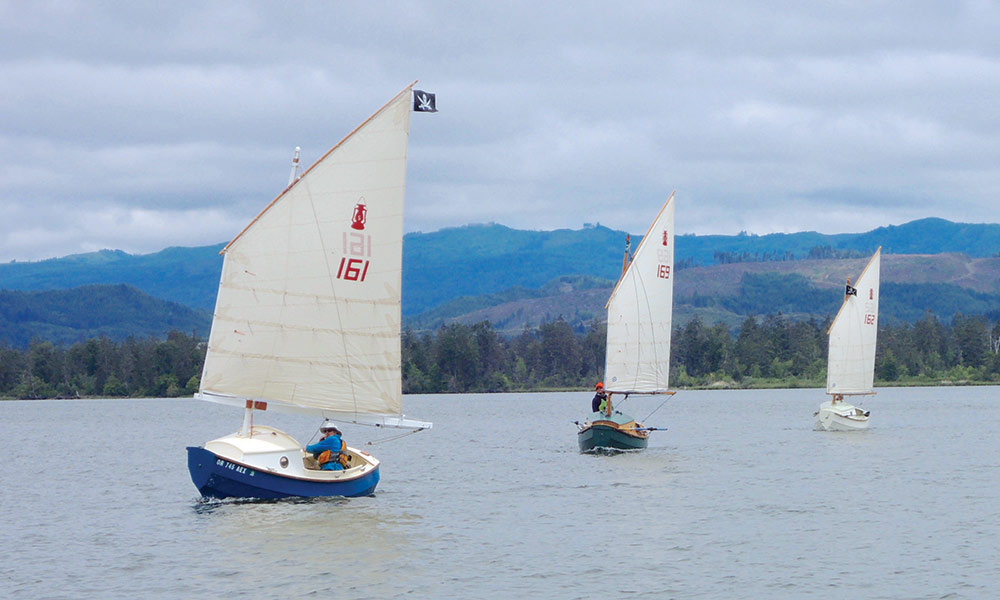
I initially expected the Scamp to sail like a bulldozer, slogging along pushing water. In reality, it moves smoothly under sail and turns on a dime, making sailing out of a marina or around other tight places deceptively easy. With only one sail and a short waterline, making 360 degree penalty turns actually feels like fun. I will admit one fault about my crush — as I’ve sailed alongside my friends in their Scamps, they are gradually outpaced by all but the shortest hulls.
I’ve been out in Scamps in a big blow, but when filled with 175 pounds of water ballast (integrated into cavities in the hull), I’ve been impressed with how stable they were. But, it wouldn’t be a sailboat if you didn’t get scared from time to time and yes, despite the broad beam and reefable sail, I’ve seen them capsize. Still, the boat is self rightable and floats high enough to bail with a little effort.

Besides being fun to sail, the Scamp is an able camp cruiser and despite its size, both Dale and Samantha have done overnight stints at anchor with their partners. Dale notes, “I think I’m a minimalist at heart, my wife and I lived in Volkswagen vans for two years, touring Europe and Australia. I love to row (and sail, even more) and don’t care much for motor boating. I have found backpacking, kayaking, camping, and living a bit ‘rough’ to be enjoyable… Big poofy pillows are allowed. Dutch ovens, too. It’s a very comfortable floating tent that turns into a kitchen, a lounge, and then a fun sailing machine… and fits in a single car garage.”
As I’ve started to play with the many strings and sticks attached to slightly larger boats, the simplicity of the Scamp keeps calling me. Sure I’d be slower and maybe not as sleek, but the comfort and adaptability of the Scamp in such a small package just keeps me smiling.
Bruce Bateau sails and rows traditional boats with a modern twist in Portland, Oregon. His stories and adventures can be found at www.terrapintales.wordpress.com.
Bruce Bateau
Bruce Bateau sails and rows traditional boats with a modern twist in Portland, Ore. His stories and adventures can be found at www.terrapintales.wordpress.com
Cruising Destinations , Featured
Destinations: Stuff Happens in Foggy Bay, Alaska
August 27, 2024

Race Reports , Featured
Northern Century 2024
August 23, 2024

Boating Lifestyle , Featured
Rum Running in the San Juan Islands
August 22, 2024

Tribal Canoe Journey: A Way of Life
August 21, 2024

Boats & Gear , Featured
August Products News
August 20, 2024

Boating News , Featured
Fall Boats Afloat Show Coming to South Lake Union
August 19, 2024

Moscow 2007
Moscow University
Moscow (Moskva) (Russian: Москва́) is the capital of Russia and the country's economic, financial, educational, and transportation centre. It is located on the Moskva River in the Central Federal District, in the European part of Russia. Moscow (Moskva) is the most populous city in Europe, whose population constitutes about 7% of the total Russian population. Historically, it was the capital of the former Soviet Union and the Grand Duchy of Moscow, the pre-Imperial Russian state. It is the site of the Kremlin, which now serves as the ceremonial residence of the President of Russia.
Soviet style building Foreign Ministry
Moscow also remains a major economic centre and is home to a large number of Russian billionaires; it was recently named as the most expensive city in the world for expatriate employees. It is home to many scientific and educational institutions, as well as numerous sport facilities. It possesses a complex transport system that includes the world's busiest metro system, which is famous for its architecture.
Library near the Kremlin
The city is named after the river (old Russian: гра́д Моско́в, literally the city by the Moskva River). The origin of the name is unknown, although several theories exist. One theory suggests that the source of the name is an ancient Finnic language, in which it means "dark" and "turbid".
Red October Candy Company
The first Russian reference to Moscow dates from 1147 when Yuri Dolgoruki called upon the prince of the Novgorod Republic to "come to me, brother, to Moscow." Nine years later, in 1156, Prince Yuri Dolgoruki of Rostov ordered the construction of a wooden wall, which had to be rebuilt multiple times, to surround the emerging city. After the sacking of 1237-1238, when the Mongol-Tatars burned the city to the ground and killed its inhabitants, Moscow recovered and became the capital of an independent principality in 1327. Its favorable position on the headwaters of the Volga River contributed to steady expansion. Moscow developed into a stable and prosperous principality for many years and attracted a large number of refugees from across Russia.
GUM department store
Under Ivan I the city replaced Tver as capital of Vladimir-Suzdal and became the sole collector of taxes for the Mongol-Tatar rulers. By paying high tribute, Ivan won an important concession from the Khan. Unlike other principalities, Moscow was not divided among his sons but was passed intact to his eldest. In 1380, prince Dmitri Donskoi of Moscow led a united Russian army to an important victory over the Tatars in the Battle of Kulikovo. Although this victory is regarded as important its result was somewhat exaggerated; the battle wasn't decisive. After 2 years of battle Moscow was completely destroyed by khan Tokhtamysh. In 1480, Ivan III had finally broken the Russians free from Tatar control, allowing Moscow to become the centre of power in Russia. Ivan III relocated the Russian capital to Moscow (the previous capital was Vladimir), and the city became the capital of an empire that would eventually encompass all of present-day Russia and other lands. In 1571, the Crimean Tatars attacked and sacked Moscow, burning everything but the Kremlin.
National Hotel on Red Square
where "The Traveler" stayed in 1963
Hotel name in Russian
In 1609 the Swedish-Finnish army led by Count Jacobus (Jaakko) De la Gardie ("Lazy Jaakko") and Evert (Eetvartti) Horn started their march from Velikiy Novgorod towards Moscow to help Tsar Vasili Shuiski, entered Moscow in 1610 and suppressed the rebellion against Tsar, but leaving it early next year 1611, following which the Polish-Lithuanian army invaded.
statue of Marshal Georgy Zhukov in front of what was the Lenin Museum
Soviet military commander who, in the course of World War II, led the Red Army to liberate the Soviet Union from the Axis Powers' occupation, to advance through much of Eastern Europe, and to conquer Germany's capital, Berlin.
The 17th century was rich in popular risings, such as the liberation of Moscow from the Polish-Lithuanian invaders (1612), the Salt Riot (1648), the Copper Riot (1662), and the Moscow Uprising of 1682. The city ceased to be Russia's capital in 1712, after the founding of St. Petersburg by Peter the Great on the Baltic coast in 1703. When Napoleon invaded Russia in 1812, the Muscovites burned the city and evacuated, as Napoleon's forces were approaching on 14 September. Napoleon's army, plagued by hunger, cold, and poor supply lines, was forced to retreat and was nearly annihilated by the devastating Russian winter and sporadic attacks by Russian military forces. In January 1905, the institution of the City Governor, or Mayor, was officially introduced in Moscow, and Alexander Adrianov became Moscow's first official mayor. Following the Russian Revolution of 1917, on March 12, 1918, Moscow became the capital of the Russian Soviet Federative Socialist Republic and the Soviet Union less than five years later.
gateway to Red Square
During the Great Patriotic War (a part of World War II after German invasion in the USSR), the Soviet State Committee of Defence and the General Staff of the Red Army was located in Moscow. In 1941, sixteen divisions of the national volunteers (more than 160,000 people), twenty-five battalions (18,500 people) and four engineering regiments were formed among the Muscovites. In November 1941, German Army Group Centre was stopped at the outskirts of the city and then driven off in the course of the Battle of Moscow. Many factories were evacuated, together with much of the government, and from October 20 the city was declared to be under siege. Its remaining inhabitants built and manned antitank defenses, while the city was bombarded from the air. It is of some note that Stalin refused to leave the city, meaning the general staff and the council of people's commissars remained in the city as well. Despite the siege and the bombings, the construction of Moscow's metro system, continued through the war and by the end of the war several new metro lines were opened. On May 1, 1944 a medal For the defense of Moscow and in 1947 another medal In memory of the 800th anniversary of Moscow were instituted. On May 8, 1965 in commemoration of the 20th anniversary of the victory in World War II, Moscow was one of twelve Soviet cities awarded the title of the Hero City. In 1980, it hosted the Summer Olympic Games.
Eternal Flame of the Unknown Soldier
In 1991 Moscow was the scene of a coup attempt by the government members opposed to the reforms of Mikhail Gorbachev. When the USSR was dissolved in the same year, Moscow continued to be the capital of Russia. Since then, the emergence of a market economy in Moscow has produced an explosion of Western-style retailing, services, architecture, and lifestyles.
Saint Basil's Cathedral
More Photos of Saint Basil's Cathedral
Moscow's architecture and performing arts culture are world-renowned. Moscow is also well known as the site of Saint Basil's Cathedral, with its elegant onion domes, as well as the Cathedral of Christ the Savior and the Seven Sisters. The Patriarch of Moscow, whose residence is the Danilov Monastery, serves as the head of the Russian Orthodox Church. Moscow also hosted the 1980 Summer Olympics. For a long time the view of the city was dominated by numerous Orthodox churches. The look of the city changed drastically during Soviet times, mostly due to Joseph Stalin, who oversaw a large-scale effort to modernise the city. He introduced broad avenues and roadways, some of them over ten lanes wide, but he also destroyed a great number of historically significant architectural works. The Sukharev Tower, as well as numerous mansions and stores lining the major streets, and various works of religious architecture, such as the Kazan Cathedral and the Cathedral of Christ the Saviour, were all destroyed during Stalin's rule. During the 1990s, however, both the latter were rebuilt.
Cathedral of Christ the Savior
More Photos of Cathedral of Christ the Savior
Architect Vladimir Shukhov was responsible for building several of Moscow's landmarks during early Soviet Russia. The Shukhov Tower, just one of many hyperboloid towers designed by Shukhov, was built between 1919 and 1922 as a transmission tower for a Russian broadcasting company. Shukhov also left a lasting legacy to the Constructivist architecture of early Soviet Russia. He designed spacious elongated shop galleries, most notably the Upper Trade Rows (GUM) on Red Square, bridged with innovative metal-and-glass vaults.
Stalin, however, is also credited with building the The Seven Sisters, comprising seven, cathedral-like structures. A defining feature of Moscow's skyline, their imposing form was allegedly inspired by the Manhattan Municipal Building in New York City, and their style - with intricate exteriors and a large central spire - has been described as Stalinist Gothic architecture. All seven towers can be seen from most elevations in the city; they are among the tallest constructions in central Moscow apart from the Ostankino Tower which, when it was completed in 1967, was the tallest free-standing land structure in the world and today remains the world's second-tallest. The Soviet policy of providing mandatory housing for every citizen and his or her family, and the rapid growth of the Muscovite population in Soviet times, also led to the construction of large, monotonous housing blocks, which can often be differentiated by age, sturdiness of construction, or 'style' according to the neighbourhood and the materials used. Most of these date from the post-Stalin era and the styles are often named after the leader then in power - Brezhnev, Khrushchev, etc - and they are usually ill-maintained.
The Stalinist-era constructions, usually in the central city, are massive and usually ornamented with Socialist realism motifs that imitate classical themes. However, small churches - almost always Eastern Orthodox - that provide glimpses of the city's past still dot various parts of the city. The Old Arbat, a popular tourist street that was once the heart of a bohemian area, preserves most of its buildings from prior to the twentieth century. Many buildings found off the main streets of the inner city (behind the Stalinist facades of Tverskaya Street, for example) are also examples of the bourgeois decadence in Tsarist times. Ostankino, Kuskovo, Uzkoye and other large estates just outside Moscow originally belong to nobles from the Tsarist era, and some convents and monasteries, both inside and outside the city, are open to Muscovites and tourists.
Attempts are being made to restore many of the city's best-kept examples of pre-Soviet architecture. These revamped structures are easily spotted by their bright new colors and spotless facades. There are a few examples of notable, early Soviet avant-garde work too, such as the house of the architect Konstantin Melnikov in the Arbat area. Later examples of interesting Soviet architecture are usually marked by their impressive size and the semi-Modernist styles employed, such as with the Novy Arbat project, familiarly known as "false teeth of Moscow" and notorious for the wide-scale disruption of a historic area in the Moscow downtown involved in the project.
Text from Wikipedia
remembering the soldiers
cruise boat on the Moskva River
Sports Arena
Novodevichy Convent
Moscow hotels, Russia
People and Places

- Plans & Kits
- Kits and Packages
- Qty in Cart

Scamp Foils Kit

SCAMP CNC PLYWOOD KIT

S.C.A.M.P. Plans Instant Download

Scamp Hardware

SCAMP Rigging Kits

Rudder Hardware for Scamp

S.C.A.M.P. Printed Plans

S.C.A.M.P. Sail
- Total: items /
- Add all to cart
Adding your products to cart

- My Boats & Boat Articles
- Boatbuilding Plans
- Scamp Sailboat

Steps in Building a SCAMP sailboat
Links to all my scamp building pages.
I started the Scamp rudder.

I looked in the leftover plywood pile and cut out some blanks to glue up the Scamp Rudder blade. I put a couple of pieces through the thickness planer to slightly reduce the thickness so now I have a quite accurate pile of wood. A little epoxy precoat so the glue will not be absorbed. This new epoxy I'm using the East epoxy is thinner than the MAS so rolls on slightly more easily.

I used slotted spreader and used thickened epoxy, (silica and wood flour). I had little wooden spacers on the table so I could put my clamps on. Just enough squeeze out to reassure me that the panel has glued properly.
I had reserved one of the four pieces of ply and not glued it on. I will glue it on after filling the blade with weight.

Meanwhile, I put in temporary screws and drafted the rudder onto the board. I'll cut the blank and decide where to put the weight. It does not have a flat spot like the centreboard so I'll have to be accurate in routing so I don't cut into the cavity when I shape the rudder.

After cutting the shape of the rudder with the band saw I fine tuned it using the belt sander, files and finally my random orbital sander. I just picked up a package of 40 grit paper and it is quite aggressive and useful for shaping.
This was not my most accurate band saw performance so the shaping took a bit of time.

I copied the plan rudder template to a piece of card by taping them to the window and tracing the shape on the cardboard. I then used the bandsaw to cut out the shape. I'm not entirely sure how to shape the rudder even with the template though since it is not a rectangular shape.
I marked the centre of the blank on the edge with a felt pen. It makes it easier to have a good mark to check against when shaping the foil.

I put a few reference marks on the edge and took off the top piece of plywood and set it aside, I had not glued it on to make it easier to enclose the weights inside the Scamp rudder.
I used the drill press with a forstner bit to make a series of holes, using a stop to keep the depth even. It was faster than using the router for such a small cavity. The instructions ask for about a kilo of weight but my plywood is heavy and I'll put in less. My centreboard turned out heavier than I expected.
It took no time at all to clean up the holes with a chisel.

After sealing the hole with epoxy placing the bits of metal and sand in the cavity I epoxied the weights and left the assembly with a piece of flat plywood over a sheet of wax paper. I'm hoping the cavity will be flush and I can just glue on the top sheet of ply and be ready to start shaping the rudder.

The surface turned out to be flat and almost flawless. I filled a couple of small holes and put thickened epoxy over the whole rudder blank surface. It was a simple step to align the top piece of plywood because of the screw holes and the marks I had made on the side.

Here is my rudder blank a-bristle with clamps. There is just enough squeeze out to make me happy. I can start shaping tomorrow.
I'm using East Epoxy
I'm making this boat using East Epoxy. So far it has performed very well. It is a 1:5 mix by volume or 100:18 by weight. It has not blushed at all. I have a few sets of test boards sitting around and so far no blush on any of the pieces, nice surfaces, good glass adhesion.
The epoxy sets smoother than I'm used to and is sandable faster. Manufacturer claims that it is completely set in 7 days.
It is slightly stiffer after setting than MAS which I've used for years. It is runnier after mixing and is easier to brush / roll on, and soaks in the wood with no problems. It wet out the cloth easily.
I decided to use it because of the price, and Noah where I bought is a reputable dealer and they like it. The Canadian dollar is not very high right now against the US dollar and this epoxy is a bit over a third the price of others. I expected it to blush but so far not the slightest blush, a nice smooth clear finish and excellent flow and wetting. It sets quickly to a sandable surface. In my shop I can sand after setting overnight.
The wood-epoxy bond seems adequate and in the joints I tested, the wood failed before the epoxy.
I'll let some of my samples sit till fully cured and I'll soak them to check their water resistance.
Shaping the Scamp Rudder
I puzzled over how to shape the rudder. In the Centreboard shaping I had been able to use the router to shape the almost parallel sides but here the shape was much more rounded and needed to blend in the tip. There is not one profile that would work so no router shaping.
I took many more photos and more detailed description of the process of SHAPING THE SCAMP RUDDER and put them here. It may not be the best possible way but it worked for me and was relatively fool proof.

After a quick cleanup of the squeezed out epoxy the rudder blank is ready to be shaped.
I have markded the blank with depths and contour lines so I have a good idea of where I want to cut and how deep.

I wasn't quite sure how to shape the rudder so I used my template cut in 2 and shaped a short section in the leading edge until that had the proper profile.
I then extended this good profile to about 8 inches from the bottom

I then went on to the trailing edge and shaped a short section with the mostly correct profile. This I also extended to about 8 inches from the bottom stopped near the bottom.
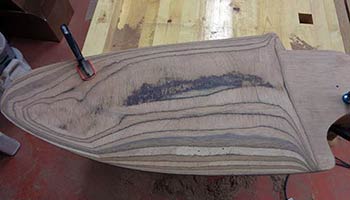
I then blended the cut so that there would be a smooth transition in the bottom.
The layers of the plywood make it possible to fairly accurately shape the rudder by making smooth lines, however not all plywood is even and some will have flaws.

This is NOT the finished shape, I will need to smooth out and fine tune some of the areas and work a bit more on the tip.
Once I have a side I'm relatively happy with I will take a photo and use that to match the second face of the rudder. This combined with the templates should help me get a fairly accurate duplication of the 2 faces.

I went back to the rudder and worked on the shape some more. It's a bit more regular and smooth. I can start on the assembly now that I have a mostly shaped rudder. I expect I will be fine tuning the top part when I see how it looks when it pivots in its case.

The rudder is formed and is almost the same on both sides. It took a lot more work to match the 2 sides than I expected. One problem was that I did not assemble the plywood blank symmetrically. This means that the plywood bands should not be identical on both sides! I also have a slightly thicker epoxy band on one joint than on the other. I used my templates more. Still a bit of final shaping but I'm almost ready for glassing.
In terms of time it would be well worth the money to purchase the already shaped foil kits that are available. I am hoping to build very economically so I chose to shape myself. Not much compromise in quality but it took a long time.

I made a stand to hold the epoxy resin and hardener. I mostly measure by weight so my scale and calculator have a spot. In the shelf I will add filler and thickeners as well as mixing tools. It will keep my precious counter space free and will keep the epoxy stuff in one place conveniently close to where I plan to assemble the Scamp.
On to: Building the Rudder Case
emails: Christine
This web site reflects my personal ideas and doesn't represent anyone else's point of view. I record the process I have followed and the result. I am not saying that it is the right or best way.
If you decide to build a boat be careful. These tools can be dangerous. If you don't know how to safely handle something find out. There are lots of forums out there.

IMAGES
COMMENTS
Installing the bow eye. Making the portholes/deadlights. Oar Socket Placement. Making the SCAMP mast. Turning SCAMP over. Sanding, marking waterline and Painting outside of hull. Finishing shaping the Bottom. Making the centreboard. Centreboard pivot and details.
On these pages, I documented progress while building a SCAMP sailboat. My SCAMP sail# is 349, and she is called "ARGO". SCAMP is an acronym for Small Craft Advisor Magazine Project, and was conceived-of by the folks at that publication. It was designed by New Zealander John Welsford, and a photo of the finished boat along with a video of the ...
SCAMP features an offset centerboard, massive flotation from sealed seats and stowage cabin, a water ballast tank holding 173 pounds of water, an after cabin "veranda" that functions like a hard dodger, and a flat bottom and skegs for beaching. PLANS: Complete plans now available on 7 24 x 36" sheets. A complete "Building guide" with suggested ...
Building a Scamp Sailboat Building the Frame. While I have spent quite a lot of time making the mast, centreboard and rudder, and cutting out all the main parts of the boat, it does not look like much. This is about to change as I start to go 3-D. The SCAMP is built right side up at first, on a curved platform.
The home port for all things SCAMP sailboat, including plans and kits. The home port for all things SCAMP sailboat, including plans and kits. top of page. HOME. Members. OWN A SCAMP. GALLERY. LINKS. SHOP. ... SCAMP Building Plans PDF DOWNLOAD. Price $149.00. Add to Cart. SCAMP Building Plans. Price $149.00. Add to Cart. SCAMP Articles Package ...
Decided to build a boat. How hard could it be? Let's find out! It's a SCAMP (designed by John Welsford). I've had my eyes on the design for a while, and ...
Steps in Building a SCAMP sailboat. Links to all my scamp building pages. SCAMP gets side planks. The Scamp has 3 sets of planks. Each is made from 6mm ply joined. The 2 bottom planks have bevels to accommodate the plank above it. Joining Planks. I used Dynamite Payson's method of joining the planks. He suggested butting the 2 sides, sanding to ...
In this video I show the assembled SCAMP building jig and discuss how to prep the hull planks for joining with precut puzzle joints.Wooden Boat Dan from Hook...
Building SCAMP, an 11 foot long, wood sailboat. Ever since I was a kid, I've been amazed with boats, much in the way my grandson flips out over trains. Learned to sail in the early 70's, at Rhode Island's Camp Yawgoog. I've been a boat nut ever since. Now I'm a restless boat nut, having sold my last boat almost 4 years ago.
Some builders come as a pair or a team and this means they also benefit from boat building instruction. There is a $500 fee for an additional builder. Some participants wish to attend SCAMP Camp to learn and then build their own boat at a later date. The tuition for this type of builder is $2,100. There is a $900 Materials fee.
In 2015 I built a scamp sailboat from a kit. I took 3 years to build it, taking my time. I did this YouTube video to encourage people to finish their Boat an...
The rest is history: More building plans and kits for SCAMP have been sold over the years than any other small cruising boat we can think of. Besides the original wooden version, Gig Harbor Boat Works was licensed in 2013 to produce a fiberglass SCAMP, and the little giant killer—in wood and fiberglass—has since its debut been at the center of various small-boat rallies, workshops and ...
The bevels are necessary because the hull planks intersect the transom at an angle, and the bottom is also angled. The transom will also get another reinforcement piece where the motor could attach. It's not easy to do this after the boat is built so I have to decide and add the backing before the seats get glued on.
SCAMP ARGO's Birdsmouth Mast is made from Sitka Spruce. Construction photos below. The plans call for a hollow wooden mast made using "birdsmouth" joints. It makes for a strong, light, and quite pretty mast. The hollow design minimizes weight aloft and makes stepping the mast easier due to the overall lighter weight.
If you build a SCAMP, you'll be joining a rapidly growing community of SCAMPers that I think have developed a special affection for all 11' 11" of this great little boat. Aside from the problem with the nesting plan, the support from Small Craft Advisor, the folks on the SCAMP forum and from the designer, John Welsford, has been truly outstanding.
The Small Craft Advisor Magazine Project (better known as SCAMP) is an increasingly popular small sailboat that can be built from plans or a kit, as well as ordered as a ready to sail fiberglass model constructed locally by Gig Harbor Boat Works. With a 100-square-foot sail, and measuring just shy of 12 feet with a beam of about five feet, the ...
Moscow 2007. Moscow University. Moscow (Moskva) (Russian: Москва́) is the capital of Russia and the country's economic, financial, educational, and transportation centre. It is located on the Moskva River in the Central Federal District, in the European part of Russia. Moscow (Moskva) is the most populous city in Europe, whose population ...
SCAMP Rigging Kits. $69.99 - $329.99. Boom and RUNNING RIGGING plus Hardware 2 10-foot lengths of 3/16" Raid Braid for 1st Reef2 20-foot lengths of 3/16" Raid Braidfor 3rd Reef4 SD-043030 3" cleats for reefing lines1 60-foot length of 3/16" Raid Braid for Topping / Lazy jack system (cut to...
Glen-L Marine Designs, Moscow, Idaho. 6,963 likes · 10 talking about this · 8 were here. Glen-L has over 300 boat plans for boats you can build. These...
Steps in Building a SCAMP sailboat. Links to all my scamp building pages. My SCAMP build, Making a Mast Cutting lots of strips for mast staves. I'm getting ready to cut the mast staves and at the same time I'll cut the support strips. Scamp seams are built using a combination of stitch and glue and strips of wood that give a point of attachment ...
Steps in Building a SCAMP sailboat. Links to all my scamp building pages. I started the Scamp rudder. I looked in the leftover plywood pile and cut out some blanks to glue up the Scamp Rudder blade. I put a couple of pieces through the thickness planer to slightly reduce the thickness so now I have a quite accurate pile of wood. A little epoxy ...
Get warmed up for the World Cup final and see the sights with this awesome set from the legend that is Paul Oakenfold on the #buboat in Moscow.
Key moments. Chosen by us to get you up to speed at a glance. 1:50pm Russian oil depot set ablaze in Ukrainian drone attack 11:58am Kremlin says Europe will face surge in prices unless Ukraine ...
THE SMART MOSCOW TOWER, a new symbol to the City of Moscow (the Dragon and the St. George's Spear).The SUPER GREEN BUILDING IS BORN.Moscow TeamProduction: Pr...